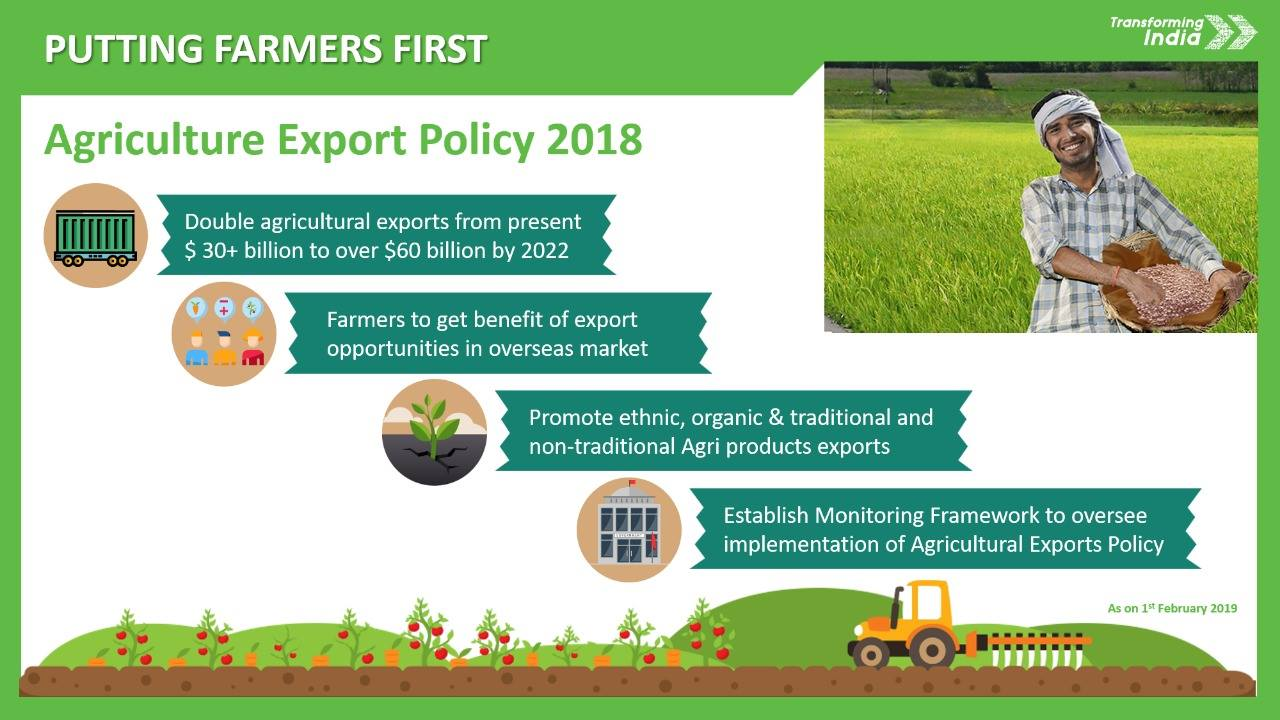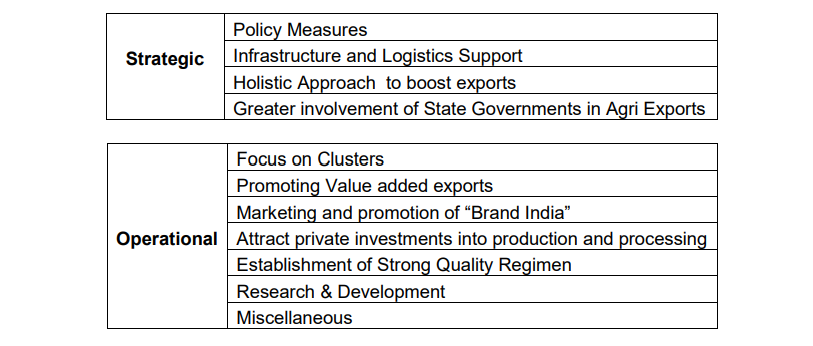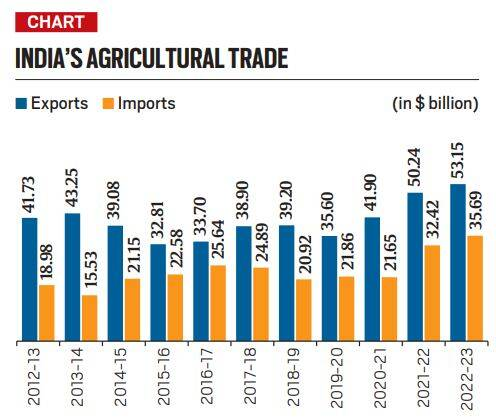Agriculture Export Policy in India | 30 Oct 2023
This editorial is based on “How we tame food inflation, and at whose cost” which was published in The Indian Express on 30 /10/2023. It talks about the drawbacks of a restrictive agricultural policy and offers suggestions for establishing a resilient and competitive agricultural export strategy.
For Prelims: Minimum Export Price (MEP), Agriculture Export Policy,Food Security, Food Inflation, Operation Greens, SAMPADA, E-NAM, APEDA, Organic Farming
For Mains: About Agricultural Export Policy, Need for an Agri Export Policy in India, Challenges in Agri Export policy in India, Steps Ahead for a Stable Agri Policy in India.
In an effort to control food inflation, the government has recently set the Minimum Export Price (MEP) for basmati rice at USD 1,200. Consequently, traders in the Punjab-Haryana region are now hesitant to purchase basmati rice, resulting in lower prices for farmers compared to when exports were not restricted.
- This high MEP may hand over India's export markets to Pakistan, its primary competitor in the basmati rice export sector. Therefore, India's agricultural export policy must shift from being restrictive to becoming stable and competitive.
What is Agricultural Export Policy?
- About :
- Agricultural export policy, often referred to as an agri export policy, is a set of government regulations, measures, and incentives designed to govern and promote the export of agricultural products from a particular country.
- The policy may include measures such as export subsidies, tariff reductions, quality standards, market access agreements, financial incentives, and trade promotion initiatives to help agricultural producers and exporters access international markets, increase their competitiveness, and expand their export opportunities.
- Vision: The Government introduced a comprehensive Agriculture Export Policy in December 2018 with a vision to harness export potential of Indian agriculture, through suitable policy instruments, to make India a global power in agriculture and raise Farmer’s income.
- Objective:
- Elements:
What is the Need for an Agri-Export Policy?
- Economic Impact: In recent years, the agricultural export sector has accounted for a substantial portion of India's total exports. For example, in the fiscal year 2022-2023, India's agricultural and processed food products export reached approximately USD 53 billion.
- However, India’s share in global exports of agriculture products was merely 2.2% in 2016.
- Food Security: India supports a substantial 17.84% of the world's population but has limited resources, with only 2.4% of the world's land and 4% of its water resources. A well-planned export policy can generate additional revenue that can be reinvested in enhancing food security and increasing the income of farmers.
- Controlling Food Inflation: Agricultural exports can help stabilize domestic prices, especially during years of bumper harvests. This price stability can benefit both consumers and producers.
- Employment Generation: As per the NSSO’s Periodic Labour Force Survey for 2021-22,the agricultural sector is the largest employer in India, with around 45% of the workforce engaged in agriculture. Promoting agricultural exports can help create more job opportunities, especially in rural areas, where livelihoods are closely tied to farming.
- Balance of Payments (BOP): In recent years, agricultural exports have contributed significantly to India's foreign exchange reserves. It helps to offset the trade deficit and maintain a stable currency.
- Crop Diversity: India is one of the world's largest producers of various agricultural commodities, including rice , wheat, spices, and horticultural products. These commodities have substantial export potential, and a well-structured export policy can harness this potential.
- Trade Relationships: India's agricultural exports are important for building and strengthening trade relationships with various countries. For instance, India's export of agricultural products to countries like the United States, Saudi Arabia, and the United Arab Emirates has steadily increased.
- Structural Challenges: The policy can address challenges in exporting agricultural products from India, such as low farm productivity, poor infrastructure, global price volatility, and market access.
What are the Challenges in Agri Export Policy of India?
- Restrictive Export Policy: The restrictive export policies, favoring domestic consumers at the expense of farmers, are considered a major reason for the failure to meet export targets.
- The MEP of USD 1,200 restricts basmati rice exports, causing a potential sharp decline in exports.
- Subsidy Centric Schemes: Populist measures, especially during election seasons, result in increased subsidies such as food subsidies for consumers and fertilizer subsidies for farmers. Many states announce loan waivers and provide free power to farmers, which, while politically popular, can negatively impact fiscal discipline and the financial health of the agricultural sector.
- Inadequate R&D Investment: India's investment in agriculture Research & Developemnt (Research and development (R&D) is limited, at around 0.5% of the agricultural Gross Domestic Product (GDP), which is insufficient to drive significant growth. This investment needs to be doubled or even tripled for India to become a powerhouse of agricultural production and exports.
- Quality and Standards: Maintaining consistent quality and meeting international standards for agricultural products is a significant challenge. Variability in quality and compliance issues can hinder exports. Meeting Sanitary and Phytosanitary (SPS) Measures of importing countries can be challenging due to the presence of pests and diseases in Indian agriculture
- Infrastructure: Inadequate infrastructure for storage, transportation, and processing can lead to post-harvest losses, reducing the competitiveness of Indian agricultural exports.
- Competitiveness: India faces competition from other countries in the global agricultural market, and being competitive in terms of pricing and quality is essential. Exchange rate fluctuations can impact the competitiveness of Indian agricultural exports.
- Environmental and Sustainability Concerns: Balancing increased agricultural exports with environmental sustainability is a challenge, as over-exploitation of resources can have long-term consequences.
What are the Government Schemes to Promote Agri-Export in India ?
- Operation Greens: Operation Greens is an initiative to stabilise the supply and prices of essential agricultural commodities, including fruits and vegetables. It aims to reduce price volatility, ensure farmers receive remunerative prices, and promote sustainable agri exports.
- Market Access Initiative (MAI): MAI is a program that supports export promotion activities, including participation in international trade fairs, capacity building, and market research. It helps Indian agricultural exporters explore new markets and gain market access.
- Scheme for Agro-Marine Processing and Development of Agro-Processing Clusters (SAMPADA): SAMPADA aims to modernise infrastructure for agro-processing clusters, which helps reduce post-harvest losses, increase the shelf life of agricultural products, and enhance the export competitiveness of Indian agri-products.
- National Horticulture Mission (NHM): NHM focuses on promoting sustainable horticulture practices, including organic farming, precision farming, and water-use efficiency. It supports the production of high-value horticultural products for export.
- E-NAM (National Agriculture Market): E-NAM is a pan-India electronic trading portal for agricultural commodities. It enables farmers to sell their produce directly to buyers, reducing intermediaries, ensuring fair prices, and enhancing sustainability.
- APEDA (Agricultural and Processed Food Products Export Development Authority): APEDA is responsible for promoting the export of scheduled products and provides guidelines for sustainability, quality, and certification requirements for exporters.
- Setting up of Agri Export Zones (AEZs): AEZs are established in different parts of the country to promote the export of specific agricultural commodities. These zones provide a conducive environment for sustainable agri exports through infrastructure development and technology adoption.
- Promotion of Organic Farming: The government has initiated programs to promote organic farming, which contributes to environmental sustainability and increases the export potential of organic products.
What are the Steps Ahead for a Stable Agri-Export Policy in India ?
- Farmer’s Welfare: Prioritize the welfare of farmers and ensure that they receive fair prices for their produce. The success of agricultural exports should directly benefit the farming community.
- Support for Domestic Consumers: To ensure food security, policy support is needed for domestic consumers, it should be through a domestic income policy targeted specifically at vulnerable sections of society.
- Productivity Enhancement: Increasing agricultural productivity is essential for competitiveness. It will require investments in R&D, seeds, irrigation, fertilizers, and better farming practices.
- Diversify Export Basket: Diversify the basket of agricultural exports, emphasize value-added products, lessen reliance on a select few commodities, and target a wide array of international markets.
- Quality Assurance: Implement strict quality standards and certification mechanisms to ensure that exported agricultural products meet international norms. There is a need to establish uniform quality and standardization protocols to ensure consistency in the quality of agricultural products, particularly for horticultural items.
- Infrastructure Development: Invest in modern infrastructure, including cold storage, processing facilities, transportation, and logistics to reduce post-harvest losses and enhance export competitiveness. Offer financial incentives, subsidies, and credit facilities to encourage investments in agriculture, infrastructure, and processing facilities.
- Technology Adoption: Promote the use of advanced agricultural technologies, precision farming, and efficient irrigation techniques to enhance productivity. Encourage the growth of agri-startups and innovative solutions to enhance agricultural production and export efficiency.
- Environmentally Sustainable Practices: Encourage sustainable farming practices, including organic farming, to ensure environmental sustainability in agriculture
- International Best Practices: Learn from successful agricultural export policies and best practices in other countries. Strengthen diplomatic efforts to negotiate favorable trade agreements and reduce trade barriers to gain better access to international markets.
Conclusion
A stable agricultural export policy should be dynamic, responsive, and adaptive to ensure India's sustained growth in the global agricultural trade market. It should prioritize the long-term sustainability of agriculture, environmental responsibility, and the welfare of farmers while promoting India's role as a significant player in world agricultural trade.
|
Drishti Mains Question Q. Discuss the key challenges faced by India in promoting agricultural exports. What measures can be taken to enhance the competitiveness and sustainability of its agricultural export sector. |
UPSC Civil Services Examination Previous Year Question (PYQ)
Prelims
Q. In India, which of the following can be considered as public investment in agriculture? (2020)
- Fixing Minimum Support Price for agricultural produce of all crops
- Computerization of Primary Agricultural Credit Societies
- Social Capital development
- Free electricity supply to farmers
- Waiver of agricultural loans by the banking system
- Setting up of cold storage facilities by the governments
Select the correct answer using the code given below:
(a) 1, 2 and 5 only
(b) 1, 3, and 4 and 5 only
(c) 2, 3 and 6 only
(d) 1, 2, 3, 4, 5 and 6
Ans:C
Q. What is/are the advantage/advantages of implementing the 'National Agriculture Market' scheme? (2017)
- It is a pan-India electronic trading portal for agricultural commodities.
- It provides the farmers access to nationwide market, with prices commensurate with the quality of their produce.
Select the correct answer using the code given below:
(a) 1 only
(b) 2 only
(c) Both 1 and 2
(d) Neither1 nor 2
Ans: C
Mains
Q. What are the main constraints in transport and marketing of agricultural produce in India? (2020)



